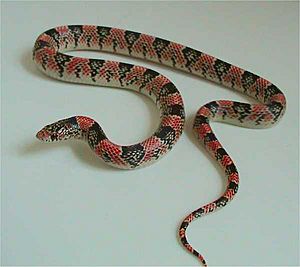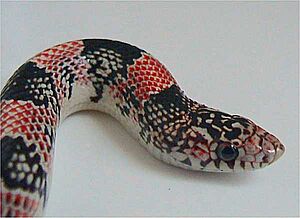Rhinocheilus lecontei tessellatus facts for kids
Quick facts for kids Rhinocheilus lecontei tessellatus |
|
|---|---|
 |
|
| Texas long-nosed snake | |
| Scientific classification |
|
| Kingdom: | Animalia |
| Phylum: | Chordata |
| Class: | Reptilia |
| Order: | Squamata |
| Suborder: | Serpentes |
| Family: | Colubridae |
| Genus: | Rhinocheilus |
| Species: | |
| Subspecies: |
R. l. tessellatus
|
| Trinomial name | |
| Rhinocheilus lecontei tessellatus Garman, 1883
|
|
| Synonyms | |
|
|
The Texas long-nosed snake (scientific name: Rhinocheilus lecontei tessellatus) is a type of snake that is not venomous. This snake is found only in the western United States and northern Mexico.
Contents
Where it Lives
The Texas long-nosed snake lives in the United States, mostly in Texas. You can also find it in New Mexico, Oklahoma, Colorado, and Kansas. It also lives in northern Mexico.
What it Looks Like
The Texas long-nosed snake has three main colors. Its body is usually cream-colored or white. It has black patches, and between these black patches, there is red. This pattern makes it look a bit like a venomous Texas coral snake.
This snake gets its name from its long snout, which is like a nose. It can grow to be about 30 inches (76 cm) long, including its tail. The longest one ever found was 41 inches (104 cm) long! In some places, the red color might be very light, making the snake look mostly black and white. In other areas, the red might look more orange or even pink.
One special thing about the Texas long-nosed snake is its snout. Unlike other long-nosed snakes, this one has a sharp snout that points slightly upwards. Also, the scale right at the tip of its nose is raised higher than the scales next to it.
How it Behaves
The Texas long-nosed snake is a shy animal. It is active at night and likes to burrow into the ground.
What it Eats
This snake eats lizards and amphibians, like frogs or salamanders. Sometimes, it might eat smaller snakes. It doesn't often eat rodents, like mice.
Reproduction
The Texas long-nosed snake lays eggs. This means it is oviparous. It lays about 4 to 9 eggs in the early summer. The baby snakes hatch from these eggs in the late summer or early fall.
How it Defends Itself
The Texas long-nosed snake is not likely to bite if you bother it. Its main way to defend itself is to release a really bad-smelling liquid. It might also release a little bit of blood from its body as a defense if it feels threatened.
Conservation Status
This type of snake does not have a special protection status from the government across most of its home range. However, it is considered vulnerable in Kansas and Oklahoma. In Colorado, it is even considered critically endangered. The biggest threat to these snakes is when their habitat (the place where they live) is destroyed.


